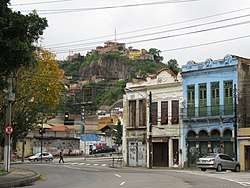Morro da Providência
Morro da Providência ("Providence Hill") is a favela located between the two Rio de Janeiro districts of Santo Cristo and Gamboa. It has an altitude of 115 metres[1] and is located in the port area of the city (currently the subject of a major revitalization known as the Porto Maravilha). It is widely considered to be the first favela community in Brazil.
"The granite hump of Providencia gazes down like a stern guardian on the old port of Rio de Janeiro. It offers probably the finest viewpoint over any city I know."[2]

History
In 1897, victorious veterans of the Canudos War who were promised land in the old capital upon their return found that such promises were not kept. In frustration and desperation, the soldiers invaded the hill scrub land close to the (then) Ministry of War. The hill was initially named Morro da Favela after the favela plant, a skin-irritating bush belonging to the spurge family, which is indigenous to the region where the soldiers fought against the Canudos settlers in the eastern province of Bahia.[3][4]
In the early 20th century, freed slaves joined the soldiers and were joined by new European migrants as well, because it was the only affordable place to live in near their work in the city's centre and port.
References
- "Geologia e Hidrografia da Cidade do Rio de Janeiro". www.educacaopublica.rj.gov.br. Retrieved 2017-07-12.
- Jenkins, Simon (2014-04-30). "Vision of the future or criminal eyesore: what should Rio do with its favelas?". The Guardian. ISSN 0261-3077. Retrieved 2017-07-13.
- Williamson, Theresa; Hora, Maurício (12 August 2012). "In the Name of the Future, Rio Is Destroying Its Past". The New York Times. Retrieved 12 December 2014.
- Pedro A. Pinto, Os Sertões de Euclides da Cunha: Vocabulário e Notas Lexiológicas, Rio: Francisco Al